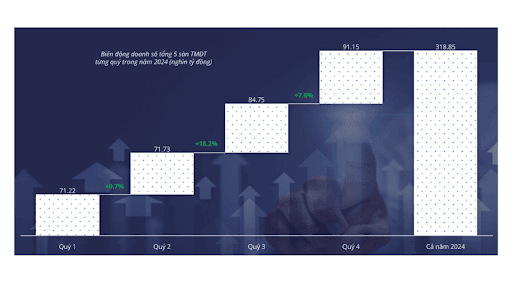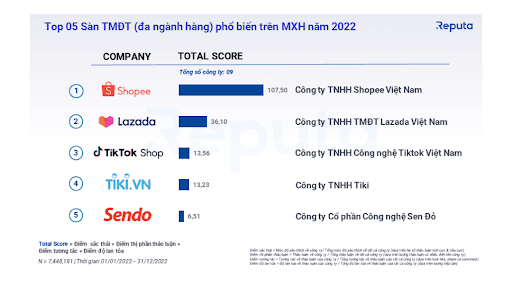
Selling on e-commerce platforms: 8-step process
In the digital era, e-commerce platforms have become a “golden ground” for Vietnamese businesses to expand their markets. They are not only a fast channel to reach customers but also a strategic choice to optimise costs and strengthen brand identity. Let’s explore the 8-step process for effective selling right below!
1. Why selling on e-commerce platforms is an inevitable trend today?
Vietnam’s e-commerce sector is booming. In 2024, the industry’s revenue reached over VND 318 trillion, demonstrating the growing appeal of online shopping channels. It is no longer a secondary option but has become a vital distribution channel for many businesses.

Source: Metric
1.1. Access to a massive and diverse customer base
Selling on e-commerce platforms allows businesses to easily expand their market. Customers are not only concentrated in major cities but also spread across rural areas and small towns.
According to YouGov, 70% of e-commerce transactions in Vietnam come from customers under 35 years old. This generation regularly shops online, providing a large and sustainable customer base.
1.2. Low startup costs and easy to begin
Compared to opening a traditional store, selling on e-commerce platforms saves significant costs on premises, staff, and operations. Most platforms now offer free basic store setup, quick registration processes, and minimal barriers.
This allows businesses to start with low capital while still reaching a large audience — a major advantage for startups as well as companies testing new products.
1.3. Comprehensive ecosystem support from e-commerce platforms
E-commerce platforms not only provide a sales platform but also offer a comprehensive support ecosystem. Businesses are integrated across payment, logistics, warehousing, advertising, and promotion.
This reduces management burdens, allowing businesses to focus on products, strategy, and customer experience. Consequently, business efficiency increases while risks decrease significantly.
Read more: What is e-commerce? The future of the global economy
2. The process for effective selling on e-commerce platforms
To achieve success on e-commerce platforms, businesses need to follow a structured process with clear steps.
Step 1: Understand platform policies and regulations
Each e-commerce platform has its own rules regarding the types of products allowed, fees, and seller rights. Businesses must clearly understand these regulations before starting.
Being well-versed in policies not only reduces the risk of violations but also ensures transparent, lawful operations while maintaining store credibility.
Step 2: Conduct market research and select suitable products
Businesses should analyse customer demand, evaluate consumption trends, and assess competition in each category. Choosing the right products not only drives sales but also helps establish a unique market advantage.
Step 3: Register an account and set up the store
Once ready, businesses register a seller account and complete the necessary procedures. Setting up the store should be carefully invested in, from name, logo, banner, to the structure of product categories.
A well-prepared store increases trust, creates confidence, and makes it easier for customers to find the products they want.
Step 4: Optimise product images, descriptions, and keywords
High-quality product images create a strong first impression. Businesses should use clear, multi-angle photos with true-to-life colours.
Additionally, descriptions should provide full details: origin, uses, materials, dimensions, instructions, and warranty policy. Combining appropriate keywords in titles and descriptions helps products appear in customer searches.
Step 5: Implement attractive promotions and incentives
Promotions are essential tools to boost sales. Businesses can apply discounts, bundle offers, free shipping, or combo deals. Time-limited promotions create scarcity, encouraging faster purchasing behaviour.

Step 6: Manage orders and control inventory
Once orders are received, processing must be swift: confirm the order, pack the product, and hand it over to the shipping provider.
Simultaneously, businesses must monitor inventory levels regularly. Effective warehouse management avoids stockouts or overstock, optimises operational costs, and ensures smooth sales processes.
Step 7: Customer care and complaint handling
Post-purchase experience is key to customer retention. Businesses should maintain contact, encourage positive reviews, and respond quickly to issues.
Complaints must be handled transparently and professionally to build trust. A well-cared-for customer is likely to return and bring in new customers.
Step 8: Monitor sales performance and optimise long-term strategies
Selling on e-commerce platforms doesn’t end at delivery. Businesses should regularly monitor key metrics: traffic, conversion rates, revenue, and advertising costs.
Based on this data, they can adjust products, optimise pricing, improve ad content, and implement more effective strategies. Continuous improvement ensures sustainable sales and long-term competitive advantages.
Read more: Amazon selling guide
3. Golden criteria for choosing the right e-commerce platform
To succeed in selling online, businesses must select a platform suitable for their product category, business goals, and available resources. The following six criteria serve as important guidance:
3.1. Target customers
Identify the target audience first. If the product targets mass consumers, a platform with a large buyer base is advantageous. Conversely, for niche markets or B2B/high-end customers, choose platforms catering to these segments.
3.2. Costs and commission policies
Each platform has its own store maintenance fees and commission rates. Businesses should calculate carefully to ensure reasonable profits after costs. Hidden fees like in-platform advertising or additional operating fees should also be considered.
3.3. Sales support tools
An effective platform should provide a modern management system. Common features include revenue reports, inventory management, promotion tools, advertising, and automated customer care. These tools save time and optimise business performance.
3.4. Scalability
As businesses grow, expanding product categories or warehouses becomes inevitable. A platform with solid infrastructure ensures smooth growth. This should be considered early to avoid disruption when sales increase rapidly.
3.5. Platform reputation and brand
Platform reputation directly affects customer trust. Prioritise platforms highly rated for brand and with clear seller/buyer protection policies. A reputable platform also reduces fraud risk and increases customer reach.
3.6. User-friendliness
An easy-to-use system ensures smooth operations and reduces training time. A customer-friendly interface also enhances buyer experience, increasing repeat purchase rates and brand loyalty.
4. Top e-commerce platforms for Vietnamese businesses
Selecting the right platform is crucial for success. Below are prominent options for Vietnamese businesses:
4.1. Popular domestic platforms
4.1.1. Shopee
Shopee, under Sea Group, is currently Vietnam’s largest e-commerce platform. With C2C and B2C models, Shopee offers a flexible environment for both individuals and businesses.
According to VnEconomy, in 2022, Shopee accounted for nearly 73% of total sales across the four largest platforms, equivalent to VND 91 trillion. Nationwide coverage and efficient operations have helped Shopee maintain its leading position.
 Source: VnEconomy
Source: VnEconomy
Strengths: Massive traffic from mega-sale events and frequent promotions. Advanced logistics allow sellers to reach millions of customers and build long-term trust.
4.1.2. TikTok Shop
TikTok Shop integrates e-commerce within the TikTok social media app, allowing users to watch videos and shop simultaneously. This seamless experience excites buyers.
According to The Influencer, in 2025, TikTok Shop captured about 39% of Vietnam’s e-commerce market, second only to Shopee. Its strength lies in combining commerce with creative content.
Businesses can sell via short videos and livestreams, telling brand stories closely. TikTok’s young audience helps products spread widely and create strong emotional connections.
4.1.3. Lazada
Lazada entered Vietnam in 2012 and is now part of Alibaba Group. As a pioneer in domestic e-commerce, it excels in logistics and commercial ecosystems.
The platform builds credibility through buyer protection policies and LazMall, which hosts authentic brands. With Fulfillment by Lazada, businesses receive warehouse, packaging, and delivery support, reducing operational burdens and allowing brand development focus.
4.2. Potential international platforms
4.2.1. Amazon
Amazon is the world’s largest e-commerce platform with hundreds of millions of customers. Through Amazon Global Selling, many Vietnamese businesses have expanded internationally.
Its main strength is Amazon FBA Fulfillment, providing end-to-end support from storage and packing to delivery. Leveraging Amazon’s global credibility, Vietnamese products can easily gain consumer trust internationally.
4.2.2. eBay
eBay, one of the oldest platforms, operates in over 190 countries. Combining auctions and direct listings, it suits unique, handmade, or collectible items.
Its strength is flexibility and low startup costs. Vietnamese businesses can reach international buyers without major investments, opening opportunities for smaller brands.
4.2.3. Walmart
Walmart Marketplace is an online platform under the leading U.S. retail group. Its highlight is combining online channels with traditional stores, reaching millions of customers.
Unlike Amazon, Walmart selects sellers carefully, reducing competition and enhancing credibility. With advanced fulfilment systems, Vietnamese brands can operate efficiently and gradually penetrate the U.S. market.
Read more: Top popular e-commerce platforms and trends in 2025
5. Q&A – Quick answers to common e-commerce questions
During e-commerce operations, businesses often have many questions. Here are some common ones with concise answers:
5.1. Do I need a business registration to sell online?
For small, occasional sales, the law sometimes allows operating without registering a business. However, organised or large-scale operations require registration to comply with e-commerce regulations.
Many platforms, like Lazada or Tiki, require sellers to provide a business license or tax code for official store registration. Registration not only legalises activities but also builds credibility with customers and partners.

5.2. Does selling on e-commerce platforms incur high costs?
Businesses bear basic fees such as payment processing, order commissions, and fixed platform charges. These directly affect profit margins.
However, costs can be controlled by choosing the right platform and utilising sales support packages. With proper operation, revenue and profit can grow strongly due to stable customer base and effective advertising tools.
5.3. Should I sell on only one platform or multiple platforms?
Selling on one platform allows focus on operations, marketing, and customer service, reducing management pressure — suitable for early-stage sellers.
Selling on multiple platforms expands market reach and reduces dependency risk. Many businesses start with 1–2 platforms to optimise operations, then expand once processes stabilise.
5.4. How to make products stand out among thousands of stores?
Start by creating professional product images with clear titles, keywords, and high-quality photos. Descriptions should be complete and emphasise benefits to differentiate.
Simultaneously, utilise in-platform ads, Flash Sale campaigns, and discount codes to increase visibility. Operational metrics like fast response rates, stable orders, and low complaint rates help improve rankings, providing sustainable competitive advantage.
6. Conclusion
In the digital era, selling on e-commerce platforms is not just a trend but a strategic move for businesses to optimise costs and expand markets. By following the 8-step process, combining flexible operations, and continuous optimisation, businesses can easily build sustainable brands and achieve long-term growth in the digital age.
AGlobal – the best cross-border e-commerce solution for businesses.
Register for a free 1-on-1 consultation tailored to your industry Here!
